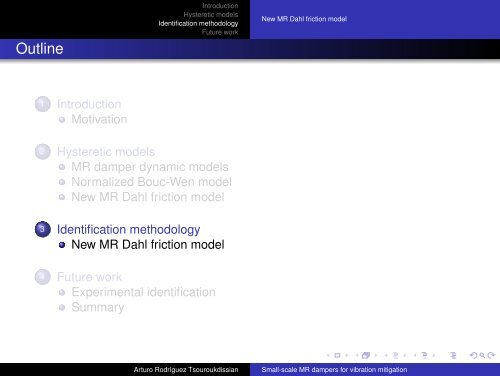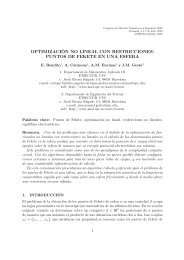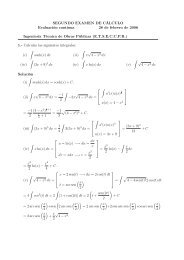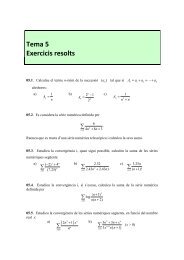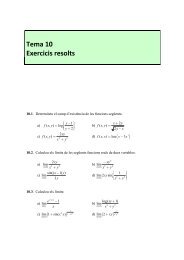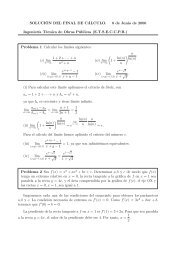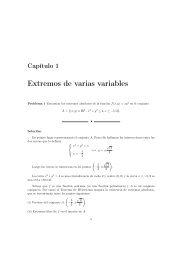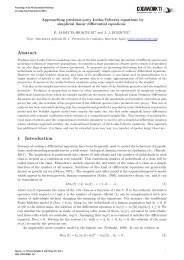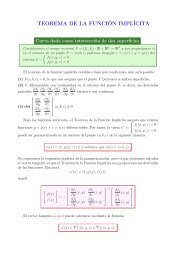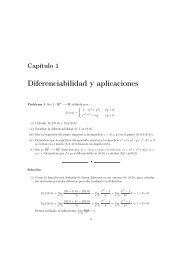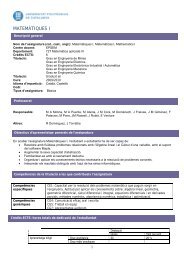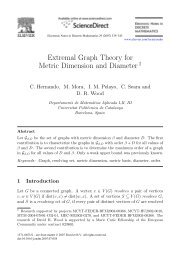Small-scale magnetorheological dampers for vibration mitigation ...
Small-scale magnetorheological dampers for vibration mitigation ...
Small-scale magnetorheological dampers for vibration mitigation ...
You also want an ePaper? Increase the reach of your titles
YUMPU automatically turns print PDFs into web optimized ePapers that Google loves.
Outline<br />
Introduction<br />
Hysteretic models<br />
Identification methodology<br />
Future work<br />
New MR Dahl friction model<br />
1 Introduction<br />
Motivation<br />
2 Hysteretic models<br />
MR damper dynamic models<br />
Normalized Bouc-Wen model<br />
New MR Dahl friction model<br />
3 Identification methodology<br />
New MR Dahl friction model<br />
4 Future work<br />
Experimental identification<br />
Summary<br />
Arturo Rodríguez Tsouroukdissian<br />
<strong>Small</strong>-<strong>scale</strong> MR <strong>dampers</strong> <strong>for</strong> <strong>vibration</strong> <strong>mitigation</strong>
Introduction<br />
Hysteretic models<br />
Identification methodology<br />
Future work<br />
New MR Dahl friction model<br />
New MR Dahl friction model identification methodology steps<br />
Identification methodology steps<br />
Ikhouane et. al. Previous considerations<br />
Step 1 Excite the system with a T-periodic input signal convex in its loading part<br />
Step 2 Compute k x<br />
Proof<br />
¯F(T + ) + ¯F(0)<br />
k x =<br />
ẋ(0) + ẋ(T + )<br />
Step 3 Compute θ(x)<br />
Proof<br />
θ(τ) with τ ∈ [0, T + ] is now known, then<br />
k w¯w(τ) = ¯F(τ) − k xẋ(τ) θ(τ)<br />
k w¯w(x) = θ(x)<br />
Arturo Rodríguez Tsouroukdissian<br />
<strong>Small</strong>-<strong>scale</strong> MR <strong>dampers</strong> <strong>for</strong> <strong>vibration</strong> <strong>mitigation</strong>
Introduction<br />
Hysteretic models<br />
Identification methodology<br />
Future work<br />
New MR Dahl friction model<br />
New MR Dahl friction model identification methodology steps<br />
Identification methodology steps<br />
Ikhouane et. al. Previous considerations<br />
Step 1 Excite the system with a T-periodic input signal convex in its loading part<br />
Step 2 Compute k x<br />
Proof<br />
¯F(T + ) + ¯F(0)<br />
k x =<br />
ẋ(0) + ẋ(T + )<br />
Step 3 Compute θ(x)<br />
Proof<br />
θ(τ) with τ ∈ [0, T + ] is now known, then<br />
k w¯w(τ) = ¯F(τ) − k xẋ(τ) θ(τ)<br />
k w¯w(x) = θ(x)<br />
Arturo Rodríguez Tsouroukdissian<br />
<strong>Small</strong>-<strong>scale</strong> MR <strong>dampers</strong> <strong>for</strong> <strong>vibration</strong> <strong>mitigation</strong>
Introduction<br />
Hysteretic models<br />
Identification methodology<br />
Future work<br />
New MR Dahl friction model<br />
New MR Dahl friction model identification methodology steps<br />
Identification methodology steps<br />
Ikhouane et. al. Previous considerations<br />
Step 1 Excite the system with a T-periodic input signal convex in its loading part<br />
Step 2 Compute k x<br />
Proof<br />
¯F(T + ) + ¯F(0)<br />
k x =<br />
ẋ(0) + ẋ(T + )<br />
Step 3 Compute θ(x)<br />
Proof<br />
θ(τ) with τ ∈ [0, T + ] is now known, then<br />
k w¯w(τ) = ¯F(τ) − k xẋ(τ) θ(τ)<br />
k w¯w(x) = θ(x)<br />
Arturo Rodríguez Tsouroukdissian<br />
<strong>Small</strong>-<strong>scale</strong> MR <strong>dampers</strong> <strong>for</strong> <strong>vibration</strong> <strong>mitigation</strong>
Introduction<br />
Hysteretic models<br />
Identification methodology<br />
Future work<br />
New MR Dahl friction model<br />
New MR Dahl friction model identification methodology steps<br />
Identification methodology steps (Cont’d)<br />
Ikhouane et. al.<br />
Step 4 Determine the zero of the function θ(x), which is the quantity x ∗ such that θ(x ∗) = 0<br />
Step 5 Compute a by using<br />
( ) dθ(x)<br />
a =<br />
dx x=x∗<br />
Step 6 Choose 1 design parameter, which is x ∗1 ≥ x ∗<br />
Step 7 Compute k w and ρ<br />
( ) dθ(x)<br />
a −<br />
dx x=x<br />
ρ =<br />
∗1<br />
θ(x ∗1 )<br />
k w = a ρ<br />
Arturo Rodríguez Tsouroukdissian<br />
<strong>Small</strong>-<strong>scale</strong> MR <strong>dampers</strong> <strong>for</strong> <strong>vibration</strong> <strong>mitigation</strong>
Introduction<br />
Hysteretic models<br />
Identification methodology<br />
Future work<br />
New MR Dahl friction model<br />
New MR Dahl friction model identification methodology steps<br />
Identification methodology steps (Cont’d)<br />
Ikhouane et. al.<br />
Step 4 Determine the zero of the function θ(x), which is the quantity x ∗ such that θ(x ∗) = 0<br />
Step 5 Compute a by using<br />
( ) dθ(x)<br />
a =<br />
dx x=x∗<br />
Step 6 Choose 1 design parameter, which is x ∗1 ≥ x ∗<br />
Step 7 Compute k w and ρ<br />
( ) dθ(x)<br />
a −<br />
dx x=x<br />
ρ =<br />
∗1<br />
θ(x ∗1 )<br />
k w = a ρ<br />
Arturo Rodríguez Tsouroukdissian<br />
<strong>Small</strong>-<strong>scale</strong> MR <strong>dampers</strong> <strong>for</strong> <strong>vibration</strong> <strong>mitigation</strong>
Introduction<br />
Hysteretic models<br />
Identification methodology<br />
Future work<br />
New MR Dahl friction model<br />
New MR Dahl friction model identification methodology steps<br />
Identification methodology steps (Cont’d)<br />
Ikhouane et. al.<br />
Step 4 Determine the zero of the function θ(x), which is the quantity x ∗ such that θ(x ∗) = 0<br />
Step 5 Compute a by using<br />
( ) dθ(x)<br />
a =<br />
dx x=x∗<br />
Step 6 Choose 1 design parameter, which is x ∗1 ≥ x ∗<br />
Step 7 Compute k w and ρ<br />
( ) dθ(x)<br />
a −<br />
dx x=x<br />
ρ =<br />
∗1<br />
θ(x ∗1 )<br />
k w = a ρ<br />
Arturo Rodríguez Tsouroukdissian<br />
<strong>Small</strong>-<strong>scale</strong> MR <strong>dampers</strong> <strong>for</strong> <strong>vibration</strong> <strong>mitigation</strong>
Introduction<br />
Hysteretic models<br />
Identification methodology<br />
Future work<br />
New MR Dahl friction model<br />
New MR Dahl friction model identification methodology steps<br />
Identification methodology steps (Cont’d)<br />
Ikhouane et. al.<br />
Step 4 Determine the zero of the function θ(x), which is the quantity x ∗ such that θ(x ∗) = 0<br />
Step 5 Compute a by using<br />
( ) dθ(x)<br />
a =<br />
dx x=x∗<br />
Step 6 Choose 1 design parameter, which is x ∗1 ≥ x ∗<br />
Step 7 Compute k w and ρ<br />
( ) dθ(x)<br />
a −<br />
dx x=x<br />
ρ =<br />
∗1<br />
θ(x ∗1 )<br />
k w = a ρ<br />
Arturo Rodríguez Tsouroukdissian<br />
<strong>Small</strong>-<strong>scale</strong> MR <strong>dampers</strong> <strong>for</strong> <strong>vibration</strong> <strong>mitigation</strong>
Introduction<br />
Hysteretic models<br />
Identification methodology<br />
Future work<br />
New MR Dahl friction model simulation<br />
New MR Dahl friction model<br />
Results<br />
New MR Dahl friction model simulation under a convex input signal in its loading part<br />
Parameters Real Identified Relative error %<br />
k x 0.0320 0.0322 0.7722<br />
k w 5.4600 5.4591 0.0170<br />
ρ 600.0000 601.4496 0.2416<br />
Arturo Rodríguez Tsouroukdissian<br />
<strong>Small</strong>-<strong>scale</strong> MR <strong>dampers</strong> <strong>for</strong> <strong>vibration</strong> <strong>mitigation</strong>
Introduction<br />
Hysteretic models<br />
Identification methodology<br />
Future work<br />
New MR Dahl friction model simulation<br />
New MR Dahl friction model<br />
Results<br />
New MR Dahl friction model simulation under a convex input signal in its loading part<br />
Parameters Real Identified Relative error %<br />
k x 0.0320 0.0322 0.7722<br />
k w 5.4600 5.4591 0.0170<br />
ρ 600.0000 601.4496 0.2416<br />
Arturo Rodríguez Tsouroukdissian<br />
<strong>Small</strong>-<strong>scale</strong> MR <strong>dampers</strong> <strong>for</strong> <strong>vibration</strong> <strong>mitigation</strong>
Outline<br />
Introduction<br />
Hysteretic models<br />
Identification methodology<br />
Future work<br />
Experimental identification<br />
Summary<br />
1 Introduction<br />
Motivation<br />
2 Hysteretic models<br />
MR damper dynamic models<br />
Normalized Bouc-Wen model<br />
New MR Dahl friction model<br />
3 Identification methodology<br />
New MR Dahl friction model<br />
4 Future work<br />
Experimental identification<br />
Summary<br />
Arturo Rodríguez Tsouroukdissian<br />
<strong>Small</strong>-<strong>scale</strong> MR <strong>dampers</strong> <strong>for</strong> <strong>vibration</strong> <strong>mitigation</strong>
Introduction<br />
Hysteretic models<br />
Identification methodology<br />
Future work<br />
Experimental identification<br />
Summary<br />
Identification of a small-<strong>scale</strong> MR controllable-friction damper<br />
Main characteristics<br />
Chrzan and Carlson, 2001<br />
Enable low cost appropriate <strong>for</strong> less<br />
demanding, low-<strong>for</strong>ce applications with a high<br />
degree of control<br />
Consists in an absorbent foam saturated with<br />
MR fluid (aprox. 3 ml).<br />
Doesn’t have an accumulator and a bypass of<br />
the fluid.<br />
Operates in a direct shear mode without seals,<br />
bearings or precision mechanical tolerance.<br />
Technical data<br />
Arturo Rodríguez Tsouroukdissian<br />
<strong>Small</strong>-<strong>scale</strong> MR <strong>dampers</strong> <strong>for</strong> <strong>vibration</strong> <strong>mitigation</strong>
Introduction<br />
Hysteretic models<br />
Identification methodology<br />
Future work<br />
Experimental identification<br />
Summary<br />
Identification of a small-<strong>scale</strong> MR controllable-friction damper<br />
Main characteristics<br />
Chrzan and Carlson, 2001<br />
Enable low cost appropriate <strong>for</strong> less<br />
demanding, low-<strong>for</strong>ce applications with a high<br />
degree of control<br />
Consists in an absorbent foam saturated with<br />
MR fluid (aprox. 3 ml).<br />
Doesn’t have an accumulator and a bypass of<br />
the fluid.<br />
Operates in a direct shear mode without seals,<br />
bearings or precision mechanical tolerance.<br />
Technical data<br />
Arturo Rodríguez Tsouroukdissian<br />
<strong>Small</strong>-<strong>scale</strong> MR <strong>dampers</strong> <strong>for</strong> <strong>vibration</strong> <strong>mitigation</strong>
Introduction<br />
Hysteretic models<br />
Identification methodology<br />
Future work<br />
Experimental identification<br />
Summary<br />
Identification of a small-<strong>scale</strong> MR controllable-friction damper<br />
Main characteristics<br />
Chrzan and Carlson, 2001<br />
Enable low cost appropriate <strong>for</strong> less<br />
demanding, low-<strong>for</strong>ce applications with a high<br />
degree of control<br />
Consists in an absorbent foam saturated with<br />
MR fluid (aprox. 3 ml).<br />
Doesn’t have an accumulator and a bypass of<br />
the fluid.<br />
Operates in a direct shear mode without seals,<br />
bearings or precision mechanical tolerance.<br />
Technical data<br />
Arturo Rodríguez Tsouroukdissian<br />
<strong>Small</strong>-<strong>scale</strong> MR <strong>dampers</strong> <strong>for</strong> <strong>vibration</strong> <strong>mitigation</strong>
Introduction<br />
Hysteretic models<br />
Identification methodology<br />
Future work<br />
Experimental identification<br />
Summary<br />
Identification of a small-<strong>scale</strong> MR controllable-friction damper<br />
Main characteristics<br />
Chrzan and Carlson, 2001<br />
Enable low cost appropriate <strong>for</strong> less<br />
demanding, low-<strong>for</strong>ce applications with a high<br />
degree of control<br />
Consists in an absorbent foam saturated with<br />
MR fluid (aprox. 3 ml).<br />
Doesn’t have an accumulator and a bypass of<br />
the fluid.<br />
Operates in a direct shear mode without seals,<br />
bearings or precision mechanical tolerance.<br />
Technical data<br />
Arturo Rodríguez Tsouroukdissian<br />
<strong>Small</strong>-<strong>scale</strong> MR <strong>dampers</strong> <strong>for</strong> <strong>vibration</strong> <strong>mitigation</strong>
Introduction<br />
Hysteretic models<br />
Identification methodology<br />
Future work<br />
Experimental identification<br />
Summary<br />
Diagram of the identification experiment layout<br />
MR damper fixed on top of the Shake Table. The sensors used are: (i) a load cell, (ii) laser<br />
displacement, and (iii) accelerometer.<br />
Arturo Rodríguez Tsouroukdissian<br />
<strong>Small</strong>-<strong>scale</strong> MR <strong>dampers</strong> <strong>for</strong> <strong>vibration</strong> <strong>mitigation</strong>
Introduction<br />
Hysteretic models<br />
Identification methodology<br />
Future work<br />
Experimental identification<br />
Summary<br />
Identification of a small-<strong>scale</strong> MR controllable-friction damper tests<br />
Experimental input current<br />
From the shear-mode MR damper model, the modified Dahl model has to include the voltage as<br />
k x(v) = k xa + k xb v<br />
k w(v) = k wa + k wb v<br />
˙v = −η(v − u)<br />
η = positive constant, u = command voltage applied to the Wonder Box, and v = is a varying<br />
voltage. η can be determined if u is available as the system is linear.<br />
Loading experiments using constant and variable input current using a convex input signal in its<br />
loading part.<br />
Arturo Rodríguez Tsouroukdissian<br />
<strong>Small</strong>-<strong>scale</strong> MR <strong>dampers</strong> <strong>for</strong> <strong>vibration</strong> <strong>mitigation</strong>
Introduction<br />
Hysteretic models<br />
Identification methodology<br />
Future work<br />
Experimental identification<br />
Summary<br />
Identification of a small-<strong>scale</strong> MR controllable-friction damper tests<br />
Experimental input current<br />
From the shear-mode MR damper model, the modified Dahl model has to include the voltage as<br />
k x(v) = k xa + k xb v<br />
k w(v) = k wa + k wb v<br />
˙v = −η(v − u)<br />
η = positive constant, u = command voltage applied to the Wonder Box, and v = is a varying<br />
voltage. η can be determined if u is available as the system is linear.<br />
Loading experiments using constant and variable input current using a convex input signal in its<br />
loading part.<br />
Arturo Rodríguez Tsouroukdissian<br />
<strong>Small</strong>-<strong>scale</strong> MR <strong>dampers</strong> <strong>for</strong> <strong>vibration</strong> <strong>mitigation</strong>
Introduction<br />
Hysteretic models<br />
Identification methodology<br />
Future work<br />
Experimental identification<br />
Summary<br />
Identification of a small-<strong>scale</strong> MR controllable-friction damper tests<br />
Experimental input current<br />
From the shear-mode MR damper model, the modified Dahl model has to include the voltage as<br />
k x(v) = k xa + k xb v<br />
k w(v) = k wa + k wb v<br />
˙v = −η(v − u)<br />
η = positive constant, u = command voltage applied to the Wonder Box, and v = is a varying<br />
voltage. η can be determined if u is available as the system is linear.<br />
Loading experiments using constant and variable input current using a convex input signal in its<br />
loading part.<br />
Arturo Rodríguez Tsouroukdissian<br />
<strong>Small</strong>-<strong>scale</strong> MR <strong>dampers</strong> <strong>for</strong> <strong>vibration</strong> <strong>mitigation</strong>
Introduction<br />
Hysteretic models<br />
Identification methodology<br />
Future work<br />
Experimental identification<br />
Summary<br />
Identification of a large-<strong>scale</strong> MR controllable-fluid damper<br />
Main characteristics<br />
Yang et. al., 2004<br />
Real-time damping is controlled by the<br />
increase in yield stress of the MR fluid in<br />
response to magnetic field strength<br />
High dissipative <strong>for</strong>ce at low velocity<br />
Continual optimization<br />
High dynamic range<br />
Inherent stability and failure-safety<br />
Mechanical simplicity<br />
Fast response-time<br />
<strong>Small</strong> device size<br />
Large temperature range<br />
Arturo Rodríguez Tsouroukdissian<br />
<strong>Small</strong>-<strong>scale</strong> MR <strong>dampers</strong> <strong>for</strong> <strong>vibration</strong> <strong>mitigation</strong>
Introduction<br />
Hysteretic models<br />
Identification methodology<br />
Future work<br />
Experimental identification<br />
Summary<br />
Identification of a large-<strong>scale</strong> MR controllable-fluid damper<br />
Main characteristics<br />
Yang et. al., 2004<br />
Real-time damping is controlled by the<br />
increase in yield stress of the MR fluid in<br />
response to magnetic field strength<br />
High dissipative <strong>for</strong>ce at low velocity<br />
Continual optimization<br />
High dynamic range<br />
Inherent stability and failure-safety<br />
Mechanical simplicity<br />
Fast response-time<br />
<strong>Small</strong> device size<br />
Large temperature range<br />
Arturo Rodríguez Tsouroukdissian<br />
<strong>Small</strong>-<strong>scale</strong> MR <strong>dampers</strong> <strong>for</strong> <strong>vibration</strong> <strong>mitigation</strong>
Introduction<br />
Hysteretic models<br />
Identification methodology<br />
Future work<br />
Experimental identification<br />
Summary<br />
Identification of a large-<strong>scale</strong> MR controllable-fluid damper<br />
Main characteristics<br />
Yang et. al., 2004<br />
Real-time damping is controlled by the<br />
increase in yield stress of the MR fluid in<br />
response to magnetic field strength<br />
High dissipative <strong>for</strong>ce at low velocity<br />
Continual optimization<br />
High dynamic range<br />
Inherent stability and failure-safety<br />
Mechanical simplicity<br />
Fast response-time<br />
<strong>Small</strong> device size<br />
Large temperature range<br />
Arturo Rodríguez Tsouroukdissian<br />
<strong>Small</strong>-<strong>scale</strong> MR <strong>dampers</strong> <strong>for</strong> <strong>vibration</strong> <strong>mitigation</strong>
Introduction<br />
Hysteretic models<br />
Identification methodology<br />
Future work<br />
Experimental identification<br />
Summary<br />
Identification of a large-<strong>scale</strong> MR controllable-fluid damper<br />
Main characteristics<br />
Yang et. al., 2004<br />
Real-time damping is controlled by the<br />
increase in yield stress of the MR fluid in<br />
response to magnetic field strength<br />
High dissipative <strong>for</strong>ce at low velocity<br />
Continual optimization<br />
High dynamic range<br />
Inherent stability and failure-safety<br />
Mechanical simplicity<br />
Fast response-time<br />
<strong>Small</strong> device size<br />
Large temperature range<br />
Arturo Rodríguez Tsouroukdissian<br />
<strong>Small</strong>-<strong>scale</strong> MR <strong>dampers</strong> <strong>for</strong> <strong>vibration</strong> <strong>mitigation</strong>
Introduction<br />
Hysteretic models<br />
Identification methodology<br />
Future work<br />
Experimental identification<br />
Summary<br />
Identification of a large-<strong>scale</strong> MR controllable-fluid damper<br />
Main characteristics<br />
Yang et. al., 2004<br />
Real-time damping is controlled by the<br />
increase in yield stress of the MR fluid in<br />
response to magnetic field strength<br />
High dissipative <strong>for</strong>ce at low velocity<br />
Continual optimization<br />
High dynamic range<br />
Inherent stability and failure-safety<br />
Mechanical simplicity<br />
Fast response-time<br />
<strong>Small</strong> device size<br />
Large temperature range<br />
Arturo Rodríguez Tsouroukdissian<br />
<strong>Small</strong>-<strong>scale</strong> MR <strong>dampers</strong> <strong>for</strong> <strong>vibration</strong> <strong>mitigation</strong>
Introduction<br />
Hysteretic models<br />
Identification methodology<br />
Future work<br />
Experimental identification<br />
Summary<br />
Identification of a large-<strong>scale</strong> MR controllable-fluid damper<br />
Main characteristics<br />
Yang et. al., 2004<br />
Real-time damping is controlled by the<br />
increase in yield stress of the MR fluid in<br />
response to magnetic field strength<br />
High dissipative <strong>for</strong>ce at low velocity<br />
Continual optimization<br />
High dynamic range<br />
Inherent stability and failure-safety<br />
Mechanical simplicity<br />
Fast response-time<br />
<strong>Small</strong> device size<br />
Large temperature range<br />
Arturo Rodríguez Tsouroukdissian<br />
<strong>Small</strong>-<strong>scale</strong> MR <strong>dampers</strong> <strong>for</strong> <strong>vibration</strong> <strong>mitigation</strong>
Introduction<br />
Hysteretic models<br />
Identification methodology<br />
Future work<br />
Experimental identification<br />
Summary<br />
Identification of a large-<strong>scale</strong> MR controllable-fluid damper<br />
Main characteristics<br />
Yang et. al., 2004<br />
Real-time damping is controlled by the<br />
increase in yield stress of the MR fluid in<br />
response to magnetic field strength<br />
High dissipative <strong>for</strong>ce at low velocity<br />
Continual optimization<br />
High dynamic range<br />
Inherent stability and failure-safety<br />
Mechanical simplicity<br />
Fast response-time<br />
<strong>Small</strong> device size<br />
Large temperature range<br />
Arturo Rodríguez Tsouroukdissian<br />
<strong>Small</strong>-<strong>scale</strong> MR <strong>dampers</strong> <strong>for</strong> <strong>vibration</strong> <strong>mitigation</strong>
Introduction<br />
Hysteretic models<br />
Identification methodology<br />
Future work<br />
Experimental identification<br />
Summary<br />
Identification of a large-<strong>scale</strong> MR controllable-fluid damper<br />
Main characteristics<br />
Yang et. al., 2004<br />
Real-time damping is controlled by the<br />
increase in yield stress of the MR fluid in<br />
response to magnetic field strength<br />
High dissipative <strong>for</strong>ce at low velocity<br />
Continual optimization<br />
High dynamic range<br />
Inherent stability and failure-safety<br />
Mechanical simplicity<br />
Fast response-time<br />
<strong>Small</strong> device size<br />
Large temperature range<br />
Arturo Rodríguez Tsouroukdissian<br />
<strong>Small</strong>-<strong>scale</strong> MR <strong>dampers</strong> <strong>for</strong> <strong>vibration</strong> <strong>mitigation</strong>
Introduction<br />
Hysteretic models<br />
Identification methodology<br />
Future work<br />
Experimental identification<br />
Summary<br />
Identification of a large-<strong>scale</strong> MR controllable-fluid damper<br />
Main characteristics<br />
Yang et. al., 2004<br />
Real-time damping is controlled by the<br />
increase in yield stress of the MR fluid in<br />
response to magnetic field strength<br />
High dissipative <strong>for</strong>ce at low velocity<br />
Continual optimization<br />
High dynamic range<br />
Inherent stability and failure-safety<br />
Mechanical simplicity<br />
Fast response-time<br />
<strong>Small</strong> device size<br />
Large temperature range<br />
Arturo Rodríguez Tsouroukdissian<br />
<strong>Small</strong>-<strong>scale</strong> MR <strong>dampers</strong> <strong>for</strong> <strong>vibration</strong> <strong>mitigation</strong>
Outline<br />
Introduction<br />
Hysteretic models<br />
Identification methodology<br />
Future work<br />
Experimental identification<br />
Summary<br />
1 Introduction<br />
Motivation<br />
2 Hysteretic models<br />
MR damper dynamic models<br />
Normalized Bouc-Wen model<br />
New MR Dahl friction model<br />
3 Identification methodology<br />
New MR Dahl friction model<br />
4 Future work<br />
Experimental identification<br />
Summary<br />
Arturo Rodríguez Tsouroukdissian<br />
<strong>Small</strong>-<strong>scale</strong> MR <strong>dampers</strong> <strong>for</strong> <strong>vibration</strong> <strong>mitigation</strong>
Summary<br />
Introduction<br />
Hysteretic models<br />
Identification methodology<br />
Future work<br />
Experimental identification<br />
Summary<br />
Presentation summary<br />
Understand the dynamic behavior of the MR <strong>dampers</strong> with a feasible<br />
hysteretic model.<br />
Apply an identification methodology to the chosen hysteretic model.<br />
Outlook <strong>for</strong> future work<br />
To do the experimental identification of the small-<strong>scale</strong> controllable<br />
friction MR damper.<br />
To do the experimental identification of the large-<strong>scale</strong> controllable<br />
friction MR damper.<br />
Arturo Rodríguez Tsouroukdissian<br />
<strong>Small</strong>-<strong>scale</strong> MR <strong>dampers</strong> <strong>for</strong> <strong>vibration</strong> <strong>mitigation</strong>
Introduction<br />
Hysteretic models<br />
Identification methodology<br />
Future work<br />
Experimental identification<br />
Summary<br />
Muchas gracias<br />
Figure: Stenocutter - longest cable stayed bridge using MR <strong>dampers</strong> <strong>for</strong> cable<br />
<strong>vibration</strong> <strong>mitigation</strong>. Hong Kong, China<br />
Arturo Rodríguez Tsouroukdissian<br />
<strong>Small</strong>-<strong>scale</strong> MR <strong>dampers</strong> <strong>for</strong> <strong>vibration</strong> <strong>mitigation</strong>
Bibliography<br />
Introduction<br />
Hysteretic models<br />
Identification methodology<br />
Future work<br />
Experimental identification<br />
Summary<br />
Tsu T. Soong and B.F. Spencer.<br />
Supplemental energy dissipation: State-of-the-art and state-of-the-practice.<br />
Engineering Structures 24(1):243–259, 2002.<br />
Michael D. Symans and Michael C. Constantinou<br />
Return<br />
Development and experimental study of semi-active fluid damping devices <strong>for</strong> seismic protection of<br />
structures.<br />
National Center <strong>for</strong> Earthquake Engineering Research. Report No. NCEER 95-0011. Buffalo, NY. 1995<br />
Return<br />
G.W. Housner, L.A. Bergman, T.K. Caughey, A.G. Chassiakos, R.O. Claus, S.F. Masri, R.E. Skelton, T.T.<br />
Soong, B.F. Spencer, and J.T.P. Yao<br />
Structural control: Past, present, and future.<br />
Journal of Engineering Mechanics 123(9):897–971, 1997.<br />
S. Nagarajaiah and S. Sahasrabudhe<br />
Return<br />
Seismic response control of smart sliding isolated buildings using variable stiffness systems: An<br />
experimental and numerical study.<br />
Earthquake Engineering and Structural Dynamics 35(2):177–197, 2005.<br />
Return<br />
N. Makris and S. McMahon<br />
Structural control with controllable fluid <strong>dampers</strong>: Design and implementation issues.<br />
Proceedings of Second International Workshop on Structural Control. Hong Kong. 1996:311Ű-322<br />
Return<br />
Arturo Rodríguez Tsouroukdissian<br />
<strong>Small</strong>-<strong>scale</strong> MR <strong>dampers</strong> <strong>for</strong> <strong>vibration</strong> <strong>mitigation</strong>
Bibliography (Cont’d)<br />
Introduction<br />
Hysteretic models<br />
Identification methodology<br />
Future work<br />
Experimental identification<br />
Summary<br />
Dorka, U.E.<br />
Testing algorithms <strong>for</strong> semiactive control of bridges.<br />
Kassel, Germany. 2000 Return<br />
Villamizar Mejia, Rodolfo<br />
Robust control of systems subjected to uncertain disturbances and actuator dynamics.<br />
PhD Universitat de Girona. 2005 Return<br />
H. Fujitani, H. Sodeyama, T. Tomura, T. Hiwatashi, Y. Shiozaki, K.Hata, K.Sunakoda, S.Morishita, and S.Soda<br />
Development of 400kN <strong>magnetorheological</strong> damper <strong>for</strong> a real base-isolated building.<br />
SPIE - Conference on Smart Structures and Materials. Bellingham, Washington. 5027:265–276<br />
Return<br />
Stanway, R., Sproston, J.L., and Stevens, N.G.<br />
Non-linear Modelling of an Electrorheological Vibration Damper.<br />
Journal of Electrostatics. 1987(20):167Ű-184 Return<br />
D. R. Gamato and F. E. Filisko<br />
Dynamic mechanical studies of electrorheological materials: Moderate frequencies.<br />
Journal of Rheology. 1991(35):399–425 Return<br />
B.F. Spencer, S.J. Dyke, M.K. Sain, and J.D. Carlson<br />
Phenomenological model of a <strong>magnetorheological</strong> damper.<br />
ASCE Journal of Engineering Mechanics. 1997(123):230-238<br />
Return<br />
Arturo Rodríguez Tsouroukdissian<br />
<strong>Small</strong>-<strong>scale</strong> MR <strong>dampers</strong> <strong>for</strong> <strong>vibration</strong> <strong>mitigation</strong>
Bibliography (Cont’d)<br />
Introduction<br />
Hysteretic models<br />
Identification methodology<br />
Future work<br />
Experimental identification<br />
Summary<br />
Y.K. Wen<br />
Method of random <strong>vibration</strong> fo hysteretic systems.<br />
Journal of Engineering Mechanics. 1976(102):246–263<br />
Return<br />
Fayçal Ikhouane and José Rodellar<br />
On the hysteretic Bouc-Wen model. Part I: Forced limit cycle characterization.<br />
Nonlinear Dynamics. 2005(42):63–78 Return<br />
Fayçal Ikhouane and José Rodellar<br />
On the hysteretic Bouc-Wen model. Part II: Robust parametric identification.<br />
Nonlinear Dynamics. 2005(42):79–95 Return<br />
Fayçal Ikhouane, Victor Mañosa, and José Rodellar<br />
Dynamic properties of the hysteretic Bouc-Wen model.<br />
Sytems and Control Letters. 2006. in press Return<br />
Fayçal Ikhouane, Oriol Gomis-Bellmunt, and Pere Castell-Vilanova<br />
A limit cycle approach <strong>for</strong> the parametric identification of hysteretic systems.<br />
Submitted to IEEE - Control Systems Technology Return<br />
Fayçal Ikhouane and Shirley J. Dyke<br />
Modeling and identification of a shear mode <strong>magnetorheological</strong> damper.<br />
Submitted to Smart Materials and Structures Return<br />
Arturo Rodríguez Tsouroukdissian<br />
<strong>Small</strong>-<strong>scale</strong> MR <strong>dampers</strong> <strong>for</strong> <strong>vibration</strong> <strong>mitigation</strong>
Bibliography (Cont’d)<br />
Introduction<br />
Hysteretic models<br />
Identification methodology<br />
Future work<br />
Experimental identification<br />
Summary<br />
Silvano Erlicher and Nelly Point<br />
Thermodynamic admissibility of BoucŰWen type hysteresis models.<br />
Comptes Rendus Mecanique. 2004(332):51–57 Return<br />
Fayçal Ikhouane, José Rodellar, and José E. Hurtado<br />
Analytical characterization of hysteresis loops described by the Bouc-Wen model.<br />
Mechanics of Advanced Materials and Structures. 2006(13):463-472 Return<br />
P. R. Dahl<br />
A solid friction model.<br />
The Aerospace Corporation, El-Segundo, TOR-158(3107-18), Cali<strong>for</strong>nia. 1968<br />
Return<br />
F. Yi, S. J. Dyke, J. M. Caicedo, and J. D. Carlson.<br />
Experimental verification of multiinput seismic control strategies <strong>for</strong> smart <strong>dampers</strong>.<br />
ASCE Journal of Engineering Mechanics. 2001(127):1152–1164 Return<br />
LORD Corp.<br />
Rheonetic Magnetorheological (MR) Fluid Technology MR damper.<br />
Cary, NC Return<br />
Arturo Rodríguez Tsouroukdissian<br />
<strong>Small</strong>-<strong>scale</strong> MR <strong>dampers</strong> <strong>for</strong> <strong>vibration</strong> <strong>mitigation</strong>
Bibliography (Cont’d)<br />
Introduction<br />
Hysteretic models<br />
Identification methodology<br />
Future work<br />
Experimental identification<br />
Summary<br />
Michael J. Chrzan and J. David Carlson<br />
MR fluid sponge devices and their use in <strong>vibration</strong> control of washing machines.<br />
SPIE - 8th Annual Symposium on Smart Structures and Materials. Newport Beach, CA. 2001<br />
Return<br />
G. Yang, B.F. Spencer, J.D. Carlson, and M.K. Sain<br />
Large-<strong>scale</strong> MR fluid <strong>dampers</strong>: Modeling and dynamic per<strong>for</strong>mance considerations.<br />
Engineering Structures. 2002(24):309–323 Return<br />
G. Yang, B.F. Spencer, H.J. Jung, and J.D. Carlson<br />
Dynamic modeling of large-<strong>scale</strong> <strong>magnetorheological</strong> damper systems <strong>for</strong> civil engineering applications.<br />
Journal of Engineering Mechanics. 2004(130):1107–1114 Return<br />
Arturo Rodríguez Tsouroukdissian<br />
<strong>Small</strong>-<strong>scale</strong> MR <strong>dampers</strong> <strong>for</strong> <strong>vibration</strong> <strong>mitigation</strong>
Proofs<br />
Introduction<br />
Hysteretic models<br />
Identification methodology<br />
Future work<br />
Experimental identification<br />
Summary<br />
Proof.<br />
Demonstration of alternative to shear-mode MR damper<br />
Previous considerations<br />
Overparametrized → per<strong>for</strong>m normalization<br />
Ikhouane and Dyke<br />
The fact that lim ρ−→∞ ψ σ,n(¯x tp) = −1 is independent from σ and n <strong>for</strong> large values of ρX max<br />
Proof<br />
Conclusion → <strong>for</strong> large values of ρX max, the values of the parameters σ and n are irrelevant.<br />
After considering the previous alternatives a new model is suggested<br />
F(T) = k vẋ(t) + k vF c(ẋ)<br />
k x and k w are voltage dependent, and F c is the Coulomb dry friction <strong>for</strong>ce representation<br />
F c(ẋ) = 1 <strong>for</strong> ẋ > 0<br />
F c(ẋ) = −1 <strong>for</strong> ẋ < 0<br />
Disadvantage → discontinuity at zero velocity or numerical instability when the ẋ of the damper is<br />
close to 0<br />
Return<br />
Arturo Rodríguez Tsouroukdissian<br />
<strong>Small</strong>-<strong>scale</strong> MR <strong>dampers</strong> <strong>for</strong> <strong>vibration</strong> <strong>mitigation</strong>
Proofs<br />
Introduction<br />
Hysteretic models<br />
Identification methodology<br />
Future work<br />
Experimental identification<br />
Summary<br />
Proof.<br />
Demonstration of alternative to shear-mode MR damper<br />
Previous considerations<br />
Overparametrized → per<strong>for</strong>m normalization<br />
Ikhouane and Dyke<br />
The fact that lim ρ−→∞ ψ σ,n(¯x tp) = −1 is independent from σ and n <strong>for</strong> large values of ρX max<br />
Proof<br />
Conclusion → <strong>for</strong> large values of ρX max, the values of the parameters σ and n are irrelevant.<br />
After considering the previous alternatives a new model is suggested<br />
F(T) = k vẋ(t) + k vF c(ẋ)<br />
k x and k w are voltage dependent, and F c is the Coulomb dry friction <strong>for</strong>ce representation<br />
F c(ẋ) = 1 <strong>for</strong> ẋ > 0<br />
F c(ẋ) = −1 <strong>for</strong> ẋ < 0<br />
Disadvantage → discontinuity at zero velocity or numerical instability when the ẋ of the damper is<br />
close to 0<br />
Return<br />
Arturo Rodríguez Tsouroukdissian<br />
<strong>Small</strong>-<strong>scale</strong> MR <strong>dampers</strong> <strong>for</strong> <strong>vibration</strong> <strong>mitigation</strong>
Proofs<br />
Introduction<br />
Hysteretic models<br />
Identification methodology<br />
Future work<br />
Experimental identification<br />
Summary<br />
Proof.<br />
Demonstration of alternative to shear-mode MR damper<br />
Previous considerations<br />
Overparametrized → per<strong>for</strong>m normalization<br />
Ikhouane and Dyke<br />
The fact that lim ρ−→∞ ψ σ,n(¯x tp) = −1 is independent from σ and n <strong>for</strong> large values of ρX max<br />
Proof<br />
Conclusion → <strong>for</strong> large values of ρX max, the values of the parameters σ and n are irrelevant.<br />
After considering the previous alternatives a new model is suggested<br />
F(T) = k vẋ(t) + k vF c(ẋ)<br />
k x and k w are voltage dependent, and F c is the Coulomb dry friction <strong>for</strong>ce representation<br />
F c(ẋ) = 1 <strong>for</strong> ẋ > 0<br />
F c(ẋ) = −1 <strong>for</strong> ẋ < 0<br />
Disadvantage → discontinuity at zero velocity or numerical instability when the ẋ of the damper is<br />
close to 0<br />
Return<br />
Arturo Rodríguez Tsouroukdissian<br />
<strong>Small</strong>-<strong>scale</strong> MR <strong>dampers</strong> <strong>for</strong> <strong>vibration</strong> <strong>mitigation</strong>
Proofs<br />
Introduction<br />
Hysteretic models<br />
Identification methodology<br />
Future work<br />
Experimental identification<br />
Summary<br />
Proof.<br />
Demonstration of alternative to shear-mode MR damper<br />
Previous considerations<br />
Overparametrized → per<strong>for</strong>m normalization<br />
Ikhouane and Dyke<br />
The fact that lim ρ−→∞ ψ σ,n(¯x tp) = −1 is independent from σ and n <strong>for</strong> large values of ρX max<br />
Proof<br />
Conclusion → <strong>for</strong> large values of ρX max, the values of the parameters σ and n are irrelevant.<br />
After considering the previous alternatives a new model is suggested<br />
F(T) = k vẋ(t) + k vF c(ẋ)<br />
k x and k w are voltage dependent, and F c is the Coulomb dry friction <strong>for</strong>ce representation<br />
F c(ẋ) = 1 <strong>for</strong> ẋ > 0<br />
F c(ẋ) = −1 <strong>for</strong> ẋ < 0<br />
Disadvantage → discontinuity at zero velocity or numerical instability when the ẋ of the damper is<br />
close to 0<br />
Return<br />
Arturo Rodríguez Tsouroukdissian<br />
<strong>Small</strong>-<strong>scale</strong> MR <strong>dampers</strong> <strong>for</strong> <strong>vibration</strong> <strong>mitigation</strong>
Proofs<br />
Introduction<br />
Hysteretic models<br />
Identification methodology<br />
Future work<br />
Experimental identification<br />
Summary<br />
Proof.<br />
Demonstration of alternative to shear-mode MR damper<br />
Previous considerations<br />
Overparametrized → per<strong>for</strong>m normalization<br />
Ikhouane and Dyke<br />
The fact that lim ρ−→∞ ψ σ,n(¯x tp) = −1 is independent from σ and n <strong>for</strong> large values of ρX max<br />
Proof<br />
Conclusion → <strong>for</strong> large values of ρX max, the values of the parameters σ and n are irrelevant.<br />
After considering the previous alternatives a new model is suggested<br />
F(T) = k vẋ(t) + k vF c(ẋ)<br />
k x and k w are voltage dependent, and F c is the Coulomb dry friction <strong>for</strong>ce representation<br />
F c(ẋ) = 1 <strong>for</strong> ẋ > 0<br />
F c(ẋ) = −1 <strong>for</strong> ẋ < 0<br />
Disadvantage → discontinuity at zero velocity or numerical instability when the ẋ of the damper is<br />
close to 0<br />
Return<br />
Arturo Rodríguez Tsouroukdissian<br />
<strong>Small</strong>-<strong>scale</strong> MR <strong>dampers</strong> <strong>for</strong> <strong>vibration</strong> <strong>mitigation</strong>
Proofs<br />
Introduction<br />
Hysteretic models<br />
Identification methodology<br />
Future work<br />
Experimental identification<br />
Summary<br />
Proof.<br />
Demonstration of alternative to shear-mode MR damper<br />
Previous considerations<br />
Overparametrized → per<strong>for</strong>m normalization<br />
Ikhouane and Dyke<br />
The fact that lim ρ−→∞ ψ σ,n(¯x tp) = −1 is independent from σ and n <strong>for</strong> large values of ρX max<br />
Proof<br />
Conclusion → <strong>for</strong> large values of ρX max, the values of the parameters σ and n are irrelevant.<br />
After considering the previous alternatives a new model is suggested<br />
F(T) = k vẋ(t) + k vF c(ẋ)<br />
k x and k w are voltage dependent, and F c is the Coulomb dry friction <strong>for</strong>ce representation<br />
F c(ẋ) = 1 <strong>for</strong> ẋ > 0<br />
F c(ẋ) = −1 <strong>for</strong> ẋ < 0<br />
Disadvantage → discontinuity at zero velocity or numerical instability when the ẋ of the damper is<br />
close to 0<br />
Return<br />
Arturo Rodríguez Tsouroukdissian<br />
<strong>Small</strong>-<strong>scale</strong> MR <strong>dampers</strong> <strong>for</strong> <strong>vibration</strong> <strong>mitigation</strong>
Proofs (Cont’d)<br />
Introduction<br />
Hysteretic models<br />
Identification methodology<br />
Future work<br />
Experimental identification<br />
Summary<br />
Proof.<br />
Regions of the hysteresis BW loops Ikhouane et. al., 2006<br />
The main slope of the linear region is ρX max. This slope comes from d¯w(¯x) at the point of the loading<br />
d¯x<br />
part of the limit cycle where ¯w(¯x) = 0<br />
The abscissa of the point P tp where the plastic region starts is ¯x tp<br />
We have<br />
lim<br />
u−→∞ ψσ,n(u) = 1<br />
Return<br />
Arturo Rodríguez Tsouroukdissian<br />
<strong>Small</strong>-<strong>scale</strong> MR <strong>dampers</strong> <strong>for</strong> <strong>vibration</strong> <strong>mitigation</strong>
Proofs (Cont’d)<br />
Introduction<br />
Hysteretic models<br />
Identification methodology<br />
Future work<br />
Experimental identification<br />
Summary<br />
Proof.<br />
Regions of the hysteresis BW loops Ikhouane et. al., 2006<br />
The main slope of the linear region is ρX max. This slope comes from d¯w(¯x) at the point of the loading<br />
d¯x<br />
part of the limit cycle where ¯w(¯x) = 0<br />
The abscissa of the point P tp where the plastic region starts is ¯x tp<br />
We have<br />
lim<br />
u−→∞ ψσ,n(u) = 1<br />
Return<br />
Arturo Rodríguez Tsouroukdissian<br />
<strong>Small</strong>-<strong>scale</strong> MR <strong>dampers</strong> <strong>for</strong> <strong>vibration</strong> <strong>mitigation</strong>
Proofs (Cont’d)<br />
Introduction<br />
Hysteretic models<br />
Identification methodology<br />
Future work<br />
Experimental identification<br />
Summary<br />
Proof.<br />
Regions of the hysteresis BW loops Ikhouane et. al., 2006<br />
The main slope of the linear region is ρX max. This slope comes from d¯w(¯x) at the point of the loading<br />
d¯x<br />
part of the limit cycle where ¯w(¯x) = 0<br />
The abscissa of the point P tp where the plastic region starts is ¯x tp<br />
We have<br />
lim<br />
u−→∞ ψσ,n(u) = 1<br />
Return<br />
Arturo Rodríguez Tsouroukdissian<br />
<strong>Small</strong>-<strong>scale</strong> MR <strong>dampers</strong> <strong>for</strong> <strong>vibration</strong> <strong>mitigation</strong>
Proofs (Cont’d)<br />
Introduction<br />
Hysteretic models<br />
Identification methodology<br />
Future work<br />
Experimental identification<br />
Summary<br />
Proof.<br />
Proof shear mode<br />
The fact that lim ρ−→∞ ψ σ,n(¯x tp) = −1 is independent from σ and n <strong>for</strong> large values of ρX max<br />
1<br />
¯x tp ≈ −1 [ϕ + σ,n<br />
ρX ( n√ 1 − r 2 ) − ϕ + σ,n (−1)]<br />
max<br />
Return<br />
Arturo Rodríguez Tsouroukdissian<br />
<strong>Small</strong>-<strong>scale</strong> MR <strong>dampers</strong> <strong>for</strong> <strong>vibration</strong> <strong>mitigation</strong>
Proofs (Cont’d)<br />
Introduction<br />
Hysteretic models<br />
Identification methodology<br />
Future work<br />
Experimental identification<br />
Summary<br />
Proof.<br />
Previous considerations in the Identification Methodology<br />
Ikhouane and Rodellar, 2005b<br />
Assumes knowledge of the limit cycle → (x(τ), ¯F(τ)) by a variable τ ∈ [0, T]<br />
Only the loading part of the input signal is considered τ ∈ [0, T + ]<br />
The equation of the loading part is<br />
¯w(x) = ψ + σ,n (ϕ+ σ,n [−ψσ,n(ρ(Xmax − X min))] + ρ(x − X min ))<br />
Its derivative is<br />
Proof<br />
Theorem 1 shows that<br />
d¯w(x)<br />
= ρ(1 − ¯w(x))<br />
dx<br />
x = X min → τ = 0 → −ψ 1,1 (ρ(X max − X min ))<br />
x = X max → τ = T + → ψ 1,1 (ρ(X max − X min ))<br />
Return<br />
Arturo Rodríguez Tsouroukdissian<br />
<strong>Small</strong>-<strong>scale</strong> MR <strong>dampers</strong> <strong>for</strong> <strong>vibration</strong> <strong>mitigation</strong>
Proofs (Cont’d)<br />
Introduction<br />
Hysteretic models<br />
Identification methodology<br />
Future work<br />
Experimental identification<br />
Summary<br />
Proof.<br />
Previous considerations in the Identification Methodology<br />
Ikhouane and Rodellar, 2005b<br />
Assumes knowledge of the limit cycle → (x(τ), ¯F(τ)) by a variable τ ∈ [0, T]<br />
Only the loading part of the input signal is considered τ ∈ [0, T + ]<br />
The equation of the loading part is<br />
¯w(x) = ψ + σ,n (ϕ+ σ,n [−ψσ,n(ρ(Xmax − X min))] + ρ(x − X min ))<br />
Its derivative is<br />
Proof<br />
Theorem 1 shows that<br />
d¯w(x)<br />
= ρ(1 − ¯w(x))<br />
dx<br />
x = X min → τ = 0 → −ψ 1,1 (ρ(X max − X min ))<br />
x = X max → τ = T + → ψ 1,1 (ρ(X max − X min ))<br />
Return<br />
Arturo Rodríguez Tsouroukdissian<br />
<strong>Small</strong>-<strong>scale</strong> MR <strong>dampers</strong> <strong>for</strong> <strong>vibration</strong> <strong>mitigation</strong>
Proofs (Cont’d)<br />
Introduction<br />
Hysteretic models<br />
Identification methodology<br />
Future work<br />
Experimental identification<br />
Summary<br />
Proof.<br />
Previous considerations in the Identification Methodology<br />
Ikhouane and Rodellar, 2005b<br />
Assumes knowledge of the limit cycle → (x(τ), ¯F(τ)) by a variable τ ∈ [0, T]<br />
Only the loading part of the input signal is considered τ ∈ [0, T + ]<br />
The equation of the loading part is<br />
¯w(x) = ψ + σ,n (ϕ+ σ,n [−ψσ,n(ρ(Xmax − X min))] + ρ(x − X min ))<br />
Its derivative is<br />
Proof<br />
Theorem 1 shows that<br />
d¯w(x)<br />
= ρ(1 − ¯w(x))<br />
dx<br />
x = X min → τ = 0 → −ψ 1,1 (ρ(X max − X min ))<br />
x = X max → τ = T + → ψ 1,1 (ρ(X max − X min ))<br />
Return<br />
Arturo Rodríguez Tsouroukdissian<br />
<strong>Small</strong>-<strong>scale</strong> MR <strong>dampers</strong> <strong>for</strong> <strong>vibration</strong> <strong>mitigation</strong>
Proofs (Cont’d)<br />
Introduction<br />
Hysteretic models<br />
Identification methodology<br />
Future work<br />
Experimental identification<br />
Summary<br />
Proof.<br />
Previous considerations in the Identification Methodology<br />
Ikhouane and Rodellar, 2005b<br />
Assumes knowledge of the limit cycle → (x(τ), ¯F(τ)) by a variable τ ∈ [0, T]<br />
Only the loading part of the input signal is considered τ ∈ [0, T + ]<br />
The equation of the loading part is<br />
¯w(x) = ψ + σ,n (ϕ+ σ,n [−ψσ,n(ρ(Xmax − X min))] + ρ(x − X min ))<br />
Its derivative is<br />
Proof<br />
Theorem 1 shows that<br />
d¯w(x)<br />
= ρ(1 − ¯w(x))<br />
dx<br />
x = X min → τ = 0 → −ψ 1,1 (ρ(X max − X min ))<br />
x = X max → τ = T + → ψ 1,1 (ρ(X max − X min ))<br />
Return<br />
Arturo Rodríguez Tsouroukdissian<br />
<strong>Small</strong>-<strong>scale</strong> MR <strong>dampers</strong> <strong>for</strong> <strong>vibration</strong> <strong>mitigation</strong>
Proofs (Cont’d)<br />
Introduction<br />
Hysteretic models<br />
Identification methodology<br />
Future work<br />
Experimental identification<br />
Summary<br />
Proof.<br />
Previous considerations in the Identification Methodology<br />
Ikhouane and Rodellar, 2005b<br />
Assumes knowledge of the limit cycle → (x(τ), ¯F(τ)) by a variable τ ∈ [0, T]<br />
Only the loading part of the input signal is considered τ ∈ [0, T + ]<br />
The equation of the loading part is<br />
¯w(x) = ψ + σ,n (ϕ+ σ,n [−ψσ,n(ρ(Xmax − X min))] + ρ(x − X min ))<br />
Its derivative is<br />
Proof<br />
Theorem 1 shows that<br />
d¯w(x)<br />
= ρ(1 − ¯w(x))<br />
dx<br />
x = X min → τ = 0 → −ψ 1,1 (ρ(X max − X min ))<br />
x = X max → τ = T + → ψ 1,1 (ρ(X max − X min ))<br />
Return<br />
Arturo Rodríguez Tsouroukdissian<br />
<strong>Small</strong>-<strong>scale</strong> MR <strong>dampers</strong> <strong>for</strong> <strong>vibration</strong> <strong>mitigation</strong>
Proofs (Cont’d)<br />
Introduction<br />
Hysteretic models<br />
Identification methodology<br />
Future work<br />
Experimental identification<br />
Summary<br />
Proof.<br />
Derivative of the loading part of the limit cycle of the new MR Dahl friction model<br />
¯w(x) = ψ + σ,n (ϕ+ σ,n [−ψσ,n(ρ(Xmax − X min))] + ρ(x − X min ))<br />
} {{ }<br />
f (x)<br />
, where<br />
∂f (x)<br />
= ρ<br />
∂x<br />
Then by using the fact that the function ψ σ,n + is the inverse of the function ϕ+ σ,n the following relationship is true<br />
∂ψ σ,n + (f (x))<br />
∂x<br />
(<br />
∂f (x) ∂ψ<br />
+ )<br />
σ,n (u)<br />
= = ρ ∗<br />
(<br />
∂x ∂u<br />
⎜<br />
u=f (x) ⎝<br />
⎛<br />
∂ϕ + σ,n (v)<br />
∂v<br />
⎞<br />
1<br />
)<br />
⎟<br />
⎠<br />
v=ψ σ,n + (f (x))<br />
The fact that ψ σ,n + (f (x)) = ¯w(x) so the previous equation becomes<br />
⎛<br />
∂¯w(x)<br />
= ρ ∗<br />
(<br />
∂x ⎜<br />
⎝<br />
∂ϕ + σ,n (v)<br />
∂v<br />
1<br />
)<br />
v=¯w(x)<br />
⎞<br />
⎟<br />
⎠<br />
Return<br />
Arturo Rodríguez Tsouroukdissian<br />
<strong>Small</strong>-<strong>scale</strong> MR <strong>dampers</strong> <strong>for</strong> <strong>vibration</strong> <strong>mitigation</strong>
Proofs (Cont’d)<br />
Introduction<br />
Hysteretic models<br />
Identification methodology<br />
Future work<br />
Experimental identification<br />
Summary<br />
Proof.<br />
Step 2 k x demonstration<br />
x = X min<br />
¯F(0) = k xẋ(0) + k w¯w(x)<br />
x = X max<br />
¯F(T + ) = k xẋ(T + ) + k w¯w(x)<br />
¯F(0) = k xẋ(0) + k w(−ψ 1,1 (ρ(X max − X min ))) ¯F(T + ) = k xẋ(0) + k w(ψ 1,1 (ρ(X max − X min )))<br />
Then if we combine the previous equations we arrive at the parameter k x the following way<br />
−¯F(0) + k xẋ(0) = ¯F(T + ) − k xẋ(T + )<br />
¯F(T + ) + ¯F(0)<br />
k x =<br />
ẋ(0) + ẋ(T + )<br />
Return<br />
Arturo Rodríguez Tsouroukdissian<br />
<strong>Small</strong>-<strong>scale</strong> MR <strong>dampers</strong> <strong>for</strong> <strong>vibration</strong> <strong>mitigation</strong>
Proofs (Cont’d)<br />
Introduction<br />
Hysteretic models<br />
Identification methodology<br />
Future work<br />
Experimental identification<br />
Summary<br />
Proof.<br />
Step 3 θ(x) demonstration<br />
Then its derivative<br />
dθ(x)<br />
= k wρ(1 − w(x))<br />
dx<br />
Defining a = k wρ and b = ρ, the derivative can be rewritten as<br />
dθ(x)<br />
= a − ρθ(x)<br />
dx<br />
Return<br />
Arturo Rodríguez Tsouroukdissian<br />
<strong>Small</strong>-<strong>scale</strong> MR <strong>dampers</strong> <strong>for</strong> <strong>vibration</strong> <strong>mitigation</strong>
<strong>Small</strong>-<strong>scale</strong> technical data<br />
Introduction<br />
Hysteretic models<br />
Identification methodology<br />
Future work<br />
Experimental identification<br />
Summary<br />
Technical data of the small-<strong>scale</strong> MR friction<br />
controllable damper<br />
LORD Corp.<br />
Stroke = 58 mm, Weight = 0.48 Kg, Input<br />
current = 0.5 A (continuous) and = 1 A<br />
(intermittent), Resistance (ambient temp.)<br />
= 20Ω<br />
Operating temperature = 70 C<br />
Damper <strong>for</strong>ces (peak-to-peak) = 100 N (5<br />
cm/sec @ 1 A) and = 2 N (20 cm/sec @ 0 A)<br />
Disadvantage → do not apply more than 0.5 A<br />
<strong>for</strong> longer than 30 sec at a time, or heat buildup<br />
may melt the plastic shaft.<br />
Wonder Box → device to control the MR<br />
damper. Power supply = 12 V DC and 2 A DC,<br />
the PC voltage signal is from 0 to 5 V DC, and<br />
the output current is from 0 to 2 A DC.<br />
Return<br />
Arturo Rodríguez Tsouroukdissian<br />
<strong>Small</strong>-<strong>scale</strong> MR <strong>dampers</strong> <strong>for</strong> <strong>vibration</strong> <strong>mitigation</strong>
<strong>Small</strong>-<strong>scale</strong> technical data<br />
Introduction<br />
Hysteretic models<br />
Identification methodology<br />
Future work<br />
Experimental identification<br />
Summary<br />
Technical data of the small-<strong>scale</strong> MR friction<br />
controllable damper<br />
LORD Corp.<br />
Stroke = 58 mm, Weight = 0.48 Kg, Input<br />
current = 0.5 A (continuous) and = 1 A<br />
(intermittent), Resistance (ambient temp.)<br />
= 20Ω<br />
Operating temperature = 70 C<br />
Damper <strong>for</strong>ces (peak-to-peak) = 100 N (5<br />
cm/sec @ 1 A) and = 2 N (20 cm/sec @ 0 A)<br />
Disadvantage → do not apply more than 0.5 A<br />
<strong>for</strong> longer than 30 sec at a time, or heat buildup<br />
may melt the plastic shaft.<br />
Wonder Box → device to control the MR<br />
damper. Power supply = 12 V DC and 2 A DC,<br />
the PC voltage signal is from 0 to 5 V DC, and<br />
the output current is from 0 to 2 A DC.<br />
Return<br />
Arturo Rodríguez Tsouroukdissian<br />
<strong>Small</strong>-<strong>scale</strong> MR <strong>dampers</strong> <strong>for</strong> <strong>vibration</strong> <strong>mitigation</strong>
<strong>Small</strong>-<strong>scale</strong> technical data<br />
Introduction<br />
Hysteretic models<br />
Identification methodology<br />
Future work<br />
Experimental identification<br />
Summary<br />
Technical data of the small-<strong>scale</strong> MR friction<br />
controllable damper<br />
LORD Corp.<br />
Stroke = 58 mm, Weight = 0.48 Kg, Input<br />
current = 0.5 A (continuous) and = 1 A<br />
(intermittent), Resistance (ambient temp.)<br />
= 20Ω<br />
Operating temperature = 70 C<br />
Damper <strong>for</strong>ces (peak-to-peak) = 100 N (5<br />
cm/sec @ 1 A) and = 2 N (20 cm/sec @ 0 A)<br />
Disadvantage → do not apply more than 0.5 A<br />
<strong>for</strong> longer than 30 sec at a time, or heat buildup<br />
may melt the plastic shaft.<br />
Wonder Box → device to control the MR<br />
damper. Power supply = 12 V DC and 2 A DC,<br />
the PC voltage signal is from 0 to 5 V DC, and<br />
the output current is from 0 to 2 A DC.<br />
Return<br />
Arturo Rodríguez Tsouroukdissian<br />
<strong>Small</strong>-<strong>scale</strong> MR <strong>dampers</strong> <strong>for</strong> <strong>vibration</strong> <strong>mitigation</strong>
<strong>Small</strong>-<strong>scale</strong> technical data<br />
Introduction<br />
Hysteretic models<br />
Identification methodology<br />
Future work<br />
Experimental identification<br />
Summary<br />
Technical data of the small-<strong>scale</strong> MR friction<br />
controllable damper<br />
LORD Corp.<br />
Stroke = 58 mm, Weight = 0.48 Kg, Input<br />
current = 0.5 A (continuous) and = 1 A<br />
(intermittent), Resistance (ambient temp.)<br />
= 20Ω<br />
Operating temperature = 70 C<br />
Damper <strong>for</strong>ces (peak-to-peak) = 100 N (5<br />
cm/sec @ 1 A) and = 2 N (20 cm/sec @ 0 A)<br />
Disadvantage → do not apply more than 0.5 A<br />
<strong>for</strong> longer than 30 sec at a time, or heat buildup<br />
may melt the plastic shaft.<br />
Wonder Box → device to control the MR<br />
damper. Power supply = 12 V DC and 2 A DC,<br />
the PC voltage signal is from 0 to 5 V DC, and<br />
the output current is from 0 to 2 A DC.<br />
Return<br />
Arturo Rodríguez Tsouroukdissian<br />
<strong>Small</strong>-<strong>scale</strong> MR <strong>dampers</strong> <strong>for</strong> <strong>vibration</strong> <strong>mitigation</strong>
<strong>Small</strong>-<strong>scale</strong> technical data<br />
Introduction<br />
Hysteretic models<br />
Identification methodology<br />
Future work<br />
Experimental identification<br />
Summary<br />
Technical data of the small-<strong>scale</strong> MR friction<br />
controllable damper<br />
LORD Corp.<br />
Stroke = 58 mm, Weight = 0.48 Kg, Input<br />
current = 0.5 A (continuous) and = 1 A<br />
(intermittent), Resistance (ambient temp.)<br />
= 20Ω<br />
Operating temperature = 70 C<br />
Damper <strong>for</strong>ces (peak-to-peak) = 100 N (5<br />
cm/sec @ 1 A) and = 2 N (20 cm/sec @ 0 A)<br />
Disadvantage → do not apply more than 0.5 A<br />
<strong>for</strong> longer than 30 sec at a time, or heat buildup<br />
may melt the plastic shaft.<br />
Wonder Box → device to control the MR<br />
damper. Power supply = 12 V DC and 2 A DC,<br />
the PC voltage signal is from 0 to 5 V DC, and<br />
the output current is from 0 to 2 A DC.<br />
Return<br />
Arturo Rodríguez Tsouroukdissian<br />
<strong>Small</strong>-<strong>scale</strong> MR <strong>dampers</strong> <strong>for</strong> <strong>vibration</strong> <strong>mitigation</strong>


